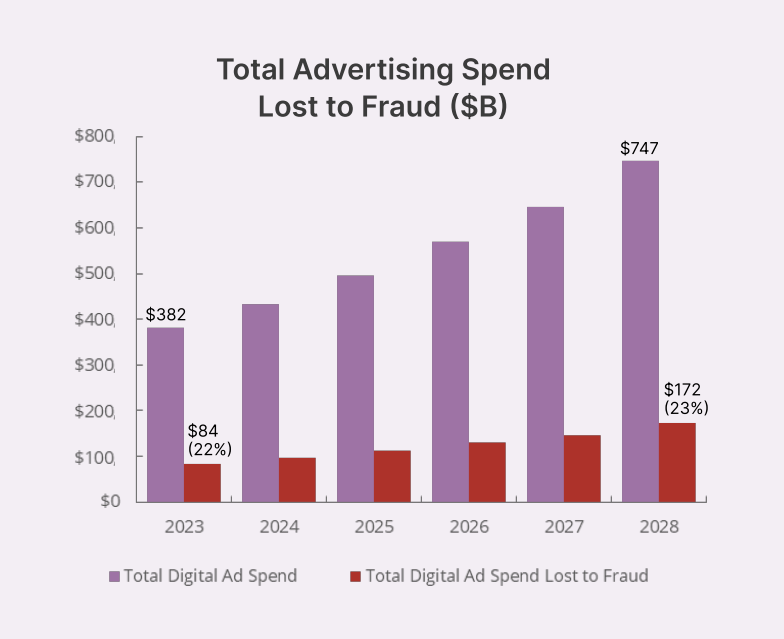
With global losses due to ad fraud projected at $100 billion by the end of the year, Ann Tarasewicz, CEO, Axis, takes a look at strategies that ad tech platforms are implementing to enhance ad fraud security in 2024.
According to Juniper Research, the global losses companies will face due to ad fraud will be about $100 billion by the end of 2024. And, as the digital world is changing rapidly, fraudsters are becoming more advanced and organized. They are already actively using artificial intelligence to create bots, and that’s not the limit.
The cybercriminal community is applying the latest technologies to test new and more effective ways to siphon money from advertisers’ budgets. The reason for this is simple. Advertisers place ads to build up their audience or customer base, and they are increasingly using mobile devices to access the Internet. This is what leads to the growing number of cybercrimes.
Fraudsters are also following technological developments and adapting the latest solutions for their own selfish and criminal purposes. Digital advertising fraudsters are rapidly increasing in number and are organizing themselves into criminal gangs to strengthen their attacks and implement new ideas.
But it’s not like ad tech is sitting idly by on this one. Let’s look deeper at the strategies that ad tech platforms are implementing to enhance ad fraud security in 2024.
Fraud Detection Algorithms
Ad exchanges and programmatic middleware solutions use strict verification procedures to ensure the authenticity of traffic sources and eliminate fraudulent impressions. This involves monitoring various metrics, including user engagement, traffic origin, and historical data, to distinguish genuine human traffic from bot-generated activity.
While it may seem complex, the crux lies in balancing security and profit preservation. A multi-tiered approach to traffic verification is indispensable in today’s landscape. Indeed, implementing a sophisticated verification system demands resource investment, yet ultimately yields benefits in the form of consistent profits and advertiser trust.
Advanced Analytics and AI
Today’s fraud detection tools leverage machine learning, data analysis, and pattern recognition techniques to assess the validity of ad impressions, clicks, and conversions, enabling advertisers and publishers to detect and block fraudulent traffic in real time. These technologies enable the analysis of vast amounts of data to identify anomalous patterns and behaviors indicative of fraudulent activity.
Machine learning algorithms can glean insights from past data and adjust to evolving fraud schemes, thereby improving the precision and effectiveness of fraud detection systems. Real-time monitoring and automated decision-making empower advertisers, publishers, and ad networks to promptly address potential threats and mitigate ad fraud before it adversely affects campaign performance.
Ad Verification Partnerships
Teaming up with specialized ad verification companies can enhance fraud prevention efforts. Collaborating with these organizations provides access to advanced tools and specialized expertise tailored for detecting and preventing ad fraud. By integrating their solutions into the platform, ad exchanges can provide advertisers with heightened transparency and confidence in the legitimacy of their ad campaigns.
Moreover, these partnerships enable continuous monitoring of ad inventory, ensuring alignment with industry standards and best practices. Prioritizing such collaborations not only fosters trust with advertisers but also reinforces the integrity of the advertising ecosystem.
Industry Initiatives
Embrace collaborative strategies in the fight against ad fraud by forming partnerships with industry initiatives such as the Trustworthy Accountability Group (TAG). Many ad exchanges have joined forces with TAG to establish standardized guidelines and protocols for fraud prevention.
TAG certification programs enable ad exchanges to showcase their commitment to ensuring transparency across all platform processes, a crucial aspect in the fight against advertising fraud. Initiatives like TAG enable the creation of a safer environment that benefits all participants in the advertising bidding process, ensuring satisfaction and preventing any grievances.
The digital advertising sector grapples with an ongoing challenge posed by ad fraud. Consequently, ad exchanges are implementing stronger measures to mitigate this threat. They are amplifying their endeavors to implement advanced and resilient prevention strategies, aiming to counteract this problem and uphold a reliable ecosystem beneficial for both advertisers and publishers.
